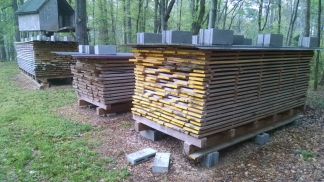Over the Easter weekend, I ventured to Colbert, Georgia to visit my family and to find the rest of the wood that I’ll need for the high chair. My parent’s homeplace is a sanctuary for the wood-lover. A mature pine and oak forest occupies most of the property, and nested within it are barns filled woodworking equipment, chainsaws, a sawmill,and a tractor with a front-end loader. Fields on both sides of the barns accommodate meticulously-stacked lumber and logs of all types that are ready to meet the same fate. Besides my home, there is probably no place else where I feel more ‘at home’.
My goal on this visit was finding a nice white oak log to provide bending stock for the continuous-arm rail and the spindles. My Dad certainly has no shortage of nice white oak logs. These beauties are bound for Kentucky to become whiskey barrels:

No worries, though; there was still plenty of stock to choose from. Besides, these logs had rings that were a bit tighter than I would prefer for bending stock. It is often assumed that faster-grown trees will yield weaker wood, but as I’ve said before, most often that is not the case. With ring-porous species like oak, faster growth actually yields stronger wood, which makes for better bending stock since the wood is less likely to splinter during tight bends.


The downside of faster-grown stock is that the sapwood band will be much wider. My log had a sapwood band 2-1/2″ wide, compared to about a 1″ band in the whiskey-barrel logs. There’s nothing inherently wrong with the sapwood, but it begins to decay in a matter of weeks, versus years for the heartwood. Luckily, my log is very fresh and the sapwood will be fine to use.
In addition to wide growth rings, there was one more compelling reason for choosing the log that I chose. It was already split in half! My Dad is an experienced feller, but he had a slight mishap as this tree fell. A large branch on this tree caught a neighboring tree as it was falling, causing this one to twist on the hinge and splitting it for twenty feet up the trunk.

I believe there may have been an impolite word uttered when the mishap occurred, but it was good news for me. I now had an entire log to choose my stock from, and it was already split in half! The first split is always the hardest, and it gets even harder as the log gets longer. Having a pre-split log not only reduces the work, but also allows me to place my cuts more strategically, since I can already see where the major defects are. It’s almost as good as X-ray goggles!
First things first: I needed a 40″ blank for the high chair’s arm rail. A full-size continuous-arm chair needs a 60″ blank, so I decided to go ahead and cut a 5′ section so I will have the wood I need on hand when I’m ready to build a full-size chair.

Having an ample number of wedges on hand made quick work of splitting out my arm rails.

I also had plenty of nieces around to help out.

Finally, I cut some shorter bolts for spindles. I truly don’t believe I’ve ever seen a nicer-splitting white oak log. At least in the Deep South, white oak tends to be far more difficult to split than red oak, with lots of tenacious interlocking fibers on the radial faces and infuriating runout when splitting the tangential faces. No such problems with this log. A single wedge easily split this large bolt without complaint.

In less than an hour, I had enough stock split out for at least five more chairs.

I brought my stock into the forested shade and went to work with the drawknife. I do believe I had the best seat in the house.
























